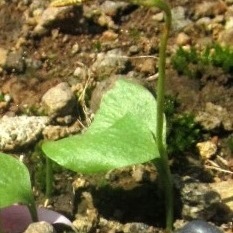Plants terrestrial. Rhizome fusiform to short-linear, to 16 mm long, to 4 mm in diameter; roots few, fleshy, horizontal, proliferous. Leaves single, rarely two or three; stipe to 60% subterranean, to 125 mm long, old stipe bases not persistent; tropophore herbaceous, bright green, held at 50-80° from the horizontal, broadly ovate to suborbicular, cordate to truncate, acute to obtuse, usually partly folded with undulate margins, to 85 mm long, to 62 mm wide. Venation reticulate. Sporophore to 190 mm long, with up to 30 sporangium pairs. Spores globose, alete or trilete, muri uneven, luminae subconical, pitted, 30-48 µm in equatorial diameter.
Rhizome fusiform to short-linear, up to 18 mm long, up to 4 mm in diam.; roots with proliferous buds. Leaves 1 or 2(3). Stipe up to 77 mm long, 35-60% of its length subterranean, stipe bases not persistent. Lamina bright green, sterile lamina of fertile frond held at 15-50° to the horizontal, sterile lamina held at 50°-80°, broadly ovate, rarely subglobose, sterile lamina of fertile frond usually partially folded, sterile lamina almost flat to slightly concave medially, up to 50 x 48 mm, apex acute to obtuse, usually apiculate, base obtuse, truncate, or cordate. Fertile spike up to 180 mm long, with up to 34 sporangia pairs, apiculate.
Rhizome cylindrical, c. 3.5 mm in diameter and 7 mm long. Fronds usually 1, less often 2 or 3; stipe subterranean for usually less than A its length, c. 90 mm long (up to 300 mm); stipe bases not persistent; sterile lamina cordate or sometimes almost reniform to broadly ovate, c. 60 x 55 mm, apex obtuse, with or without a small mucro, base cordate to broadly cuneate; venation clearly apparent; fertile spike inserted at base of sterile lamina, or up to 10 mm below apparent base, up to 180 mm long with up to 45 pairs or sporangia, apiculus narrowly to broadly acute, c. 3 mm long.
Plants 10-30 cm tall. Rhizomes erect, slender, bearing a few thick fleshy roots. Common stalk 4-8 cm, light green, gradually pale toward base. Sterile lamina with a short stalk or almost sessile, ovate or orbicular-ovate, 3-4 × 2.6-3.5 cm, herbaceous, base deeply cordate, margin ± wavy, apex rounded or subobtuse; veins distinct, reticulate. Sporophore arising from base of sterile lamina, slender, 10-15 cm; spike 3-3.5 cm, slender. Spore surface regularly or irregularly subreticulate. 2n = 240-1280.
A small fern. It is a herb. It grows 5-35 cm high. The rhizome is like a cylinder with many thin roots. The stalk of the frond is 3-8 cm long. The fronds are distinct. The sterile fronds are 3.5 cm long by 2 cm wide. They are oval and the base is heart shaped. The fertile frond is 2-2.5 cm long and on a slender stalks coming from the base of the sterile frond. This plant varies in different countries and regions.
Rhizome cylindrical, ± 3.5 mm in diameter and 7 mm long. Old stipe bases not persistent. Base of sterile lamina cordate; venation clearly apparent. Lamina ± 60 x 55 mm. Fertile spike up to 180 mm long, with 45 pairs of sporangia.


